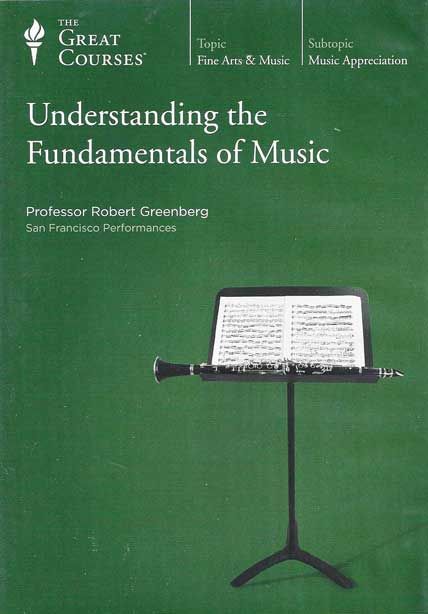
We all know that beneath the surface of music, beyond the joy or excitement or even heartache that this beautiful language of sound can stir within us, lies the often mysterious realm of music theory—a complex syntax of structural and instrumental resources that composers may draw on. No matter what kind of music we listen to—symphony or string quartet, saxophone solo or vocal ballad, hip hop or Gregorian chant—we feel the impact of that music and have done so all our lives, even though we may not know how such impact is achieved, or understand the fundamental processes of musical composition.
But what if we did understand how certain musical effects were achieved? What if we could learn to follow the often-intimidating language of key signatures, pitch, mode, melody, meter, and other parts of musical structure used by composers? What if we could recognize these various components at work as we listened to our favorite music? What if we could “speak” the language of Western music? It’s a language that Professor Robert Greenberg calls rich, varied, and magnificent, and he has little doubt about the rewards of even a beginning level of fluency. “It’s a language that pays us back tenfold—a hundredfold—for every detail we come to recognize and perceive! And it’s a language that will only get richer and more varied, as our increasingly global culture contributes ever more vocabulary to it.”
Learn the Basics of Music Theory without Knowing How to Read Music!
In this course, Professor Greenberg offers a spirited introduction to this magnificent language—nimbly avoiding what for many of us has long been the principal roadblock, the need to read music. For anyone wanting to master music’s language, being able to read musical notation is a necessity. But this course, as Professor Greenberg notes, is a basic course, designed to introduce you to music’s language in a way that is similar to the way you learned your own native language, by “discovering and exploring musical syntax through our ears—by learning what the parts of musical speech sound like—rather than what they look like on paper.” By sidestepping the necessity to read music, these lectures represent an extremely rare opportunity in musical education—an opportunity to experience a solid introduction to music theory’s basics in a way that is not technically intimidating, yet provides a substantial grounding in the fundamentals. As such, Professor Greenberg has devised a highly individualized approach to music theory. There is simply little or no literature in this field that can teach as much without recourse to music notation. Thus, it can appeal to those who are not learning, or even planning to learn, to play a musical instrument or to compose. It can even be beneficial to musicians who do not play a keyboard instrument and may have had difficulty grasping some of the more abstract concepts of music. As much as anything else, the course is designed to help deepen and intensify the experience of Professor Greenberg’s other Teaching Company Courses, currently 21 in number. Professor Greenberg has made use of a variety of tools, including thoughtfully chosen recorded examples, his own demonstrations at the piano, and helpful diagrams. One of those diagrams—a reproduction of a piano keyboard, with its keys identified—frees the student from needing access to a piano or any other keyboard instrument, a traditional demand of most music theory courses. It’s of tremendous help in visualizing many of the course’s most important concepts, such as how “pitch collections” are built, and it opens up the benefits of this course to anyone without access to a piano or keyboard instrument. The extent of those benefits becomes clear the moment you start to apply the basic knowledge taught in this course. You’ll listen to music with new levels of understanding and appreciation, not only when you find yourself at the concert hall, but also at home with your stereo, and when you’re listening to your favorite music in the car or on a portable player.
Listen Over and Over and Learn More Each Time!
Each time you listen to this course—and Professor Greenberg has designed it to be listened to again and again—you increase your music-listening skills and come to appreciate what a complex and rewarding study music theory can be. These are lectures that will prepare you, in Professor Greenberg’s words, to “hear and identify those aspects of the musical language that are, collectively, the means to comprehending, on an intimate level, the music of the Western repertoire and, to a significant degree, the music of many other world cultures as well.” It’s difficult to imagine a teacher more qualified to help you reach that goal. Professor Greenberg is one of The Teaching Company’s most highly regarded, popular, and prolific teachers—as well as an award-winning composer in his own right. He has produced more than 500 lectures for The Teaching Company on a range of composers and genres, each marked by his characteristic knowledge, enthusiasm, humor, and, most important, unique ability to teach the technicalities of music to nontechnical audiences. A love of music and a desire to understand it are the only prerequisites you need. All these skills are on constant display throughout the lectures, as Professor Greenberg takes you step by step through the material, laying a firm foundation before introducing the next concept. He begins by introducing you to the instrumental families of the orchestra and their characteristics, before moving on to subjects that might seem intimidating in a classroom: pulse and meter; sound, pitch, and pitch collections; melody and texture; tonality and tonal harmony. Professor Greenberg’s lectures are clear and purposeful.
Learn about the People behind the Music
Along the way, you’ll learn the human side of music—about the men and women who write and play it—and discover, for example, that:
When violinists or other string players use the bow over the fingerboard, or neck, of their instruments, a lovely, flutelike sound is produced, similar to the effect of clamping a comb-shaped muting device to the instrument’s bridge. The technique is called sul tasto. Even though it is an effect that can be achieved instantly, without having to pause to clamp on a mute, string players generally dislike it. That’s because the rosin they use on the hair of their bows to make the hair grip the strings gets on a part of the strings that may come into contact with the players’ fingers—an unwelcome experience for string players. Not wishing to incur the wrath of the string section, experienced composers have thus learned to avoid using sul tasto unless absolutely necessary.
The piccolo has so much power that its piercingly brilliant sound can be painful, so piccolo players wear earplugs when they practice to protect themselves from their own instruments.
The extraordinary two-and-a-half octave upward slide—or glissando—that begins George Gershwin’s 1924 Rhapsody in Blue has become the most famous clarinet glissando in all of music. Gershwin did not write it that way; he indicated a simple ascending scale. But Gershwin’s original score was written for piano and then orchestrated by Ferde Grofé. Grofé knew that Russ Gorman, who would play clarinet in the Rhapsody’s premiere, was extraordinarily gifted at playing glissandi. Grofé thus scored the opening of Rhapsody as a glissando, and the rest is musical history.
Hector Berlioz was rare among major composers for barely being able to play any individual musical instrument. The “instrument” he could play was the orchestra. Considered the most original, adventurous, and innovative orchestrator that had yet come along, his “Treatise on Orchestration” has been a must-read for composers and conductors since its publication in 1843.
Understanding the Fundamentals of Music is as rich in musical lore as it is in technical knowledge. It will reward you many times over, not only as you listen and relisten to the lectures, gaining a new understanding each time, but also as you listen to different varieties of music and find yourself enjoying a much deeper understanding of their compositional structures.
Course Lecture Titles
01. The Language of Music
02. Timbre, Continued
03. Timbre, Part 3
04. Beat and Tempo
05. Meter, Part 1
06. Meter, Part 2
07. Pitch and Mode, Part 1
08. Pitch and Mode, Part 2
09. Intervals and Tunings
10. Tonality, Key Signature, and the Circle of Fifths
11. Intervals Revisited and Expanded
12. Melody
13. Melody, Continued
14. Texture and Harmony, Part 1
15. Harmony, Part 2—Function, Tendency, and Dominance
16. Harmony, Part 3—Progression, Cadence, and Modulation
http://www.rarefile.net/6fw0u2bkh4li/Understanding.Fundamentals.Music.part01.rar
http://www.rarefile.net/x7ycw2r29hh3/Understanding.Fundamentals.Music.part02.rar
http://www.rarefile.net/8z2d9d0sgabn/Understanding.Fundamentals.Music.part03.rar
http://www.rarefile.net/o476a0nt6qca/Understanding.Fundamentals.Music.part04.rar
http://www.rarefile.net/nq0i331c5xz8/Understanding.Fundamentals.Music.part05.rar
http://www.rarefile.net/4ftscfes02di/Understanding.Fundamentals.Music.part06.rar
http://www.rarefile.net/1xtd2dhclefs/Understanding.Fundamentals.Music.part07.rar
http://www.rarefile.net/wp1yh3fphe01/Understanding.Fundamentals.Music.part08.rar
http://www.rarefile.net/7cyu4d7dwqb7/Understanding.Fundamentals.Music.part09.rar
http://www.rarefile.net/jesokzlr5uf1/Understanding.Fundamentals.Music.part10.rar
http://www.rarefile.net/cr56rnxucbm1/Understanding.Fundamentals.Music.part11.rar
http://www.rarefile.net/fssjxtlwj68t/Understanding.Fundamentals.Music.part12.rar
.

















0 Response to this entry.